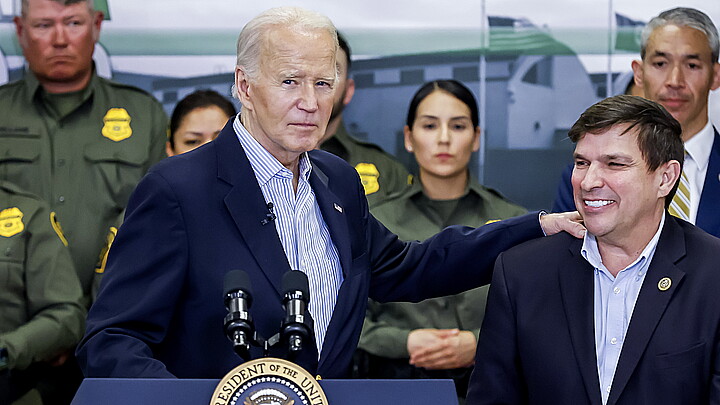Immigration
Two decades of America struggling for immigration reform and border security
While President Joe Biden has finally made his long anticipated trip to the southwest border in Texas, many are left wondering why the United States has been unable to pass any meaningful immigration reform as a legal mechanism to get the border situation under control.
January 9, 2023 12:05am
Updated: January 9, 2023 10:12am
Past presidents and Congresses have struggled and failed to muster the votes necessary to pass any legislative reform, leaving the future a mystery for the border and those who continue to cross it—and live amid the crossings.
Many hoped the border would come under control when former Republican Texas Gov. George W. Bush succeeded former Democratic President Bill Clinton.
As a veteran two-term Texan governor who had developed a positive relationship with conservative Mexican President Vicente Fox, many believed the son of former President George H.W. Bush would be able to pull it off.
The former Texas governor and Air National Guard fighter pilot didn’t waste any time in taking his chances. Immediately after getting sworn into office in 2001, Bush collaborated with Fox on what were then revolutionary ideas for new legislation including a guest worker program.
That program would have offered some legitimacy the then 8.5 million undocumented migrants living in the U.S.
In a gesture of goodwill, Bush visited Mexico in his first visit to a foreign nation, and in turn, Fox came to Washington for Bush's first state dinner from Sept. 5-6.
Those talks took a back burner however in a short time after al-Qaeda terrorists hijacked four planes and attacked the Pentagon and Twin Towers in Manhattan on Sept. 11, 2001—a devastating blow to U.S. national security which led to the PATRIOT Act and a huge turn toward closed immigration.
Four years later, while Bush was still handling the War on Terror and the Iraq War, a coalition between Republican Sen. John McCain and Democratic Sen. Edward Kennedy resulted in the Secure America and Orderly Immigration Act (SAOIA).
Had it been passed, the SAOIA would have offered undocumented migrants six-year work visas while giving them an opportunity to become legal residents—if they passed background checks and paid past due fines.
The SAOIA would have also created an “essential worker visa” permitting 400,000 migrants per year to work and pursue legal residency.
While Sens. McCain and Kennedy were working on the SAOIA in 2005, House Republicans worked on a different type of bill that was a preview of what would later become President Donald Trump’s famous border wall.
House Republicans drafted alternative legislation that originated with former Rep. James Sensenbrenner.
The legislation, known as H.R. 4437, which was largely a mechanism to deter illegal immigration would have enhanced penalties for illegal immigration and would have made it a felony for Americans to help anyone cross the border.
It also called for the actual construction of a border wall barrier, similar to Trump’s proposal, which was finally—at least partially realized—during his presidential administration from 2017-2021.
The bill included the following:
· An amendment to eliminate the diversity visa lottery
· A manager's amendment that, among other things, makes misuse of passports or travel documents an aggravated felony even if committed by a refugee or a victim of domestic violence or trafficking
· An amendment giving state and local law enforcement officials the "inherent authority" to enforce civil immigration laws
· An amendment withholding grant funds from state and local governments that maintain a policy of protecting the confidentiality of immigrants
· An amendment vesting USCIS with law enforcement powers over certain investigations, and allowing the Office of Security and Investigations to engage in data-mining of DHS databases
· An amendment further increasing penalties for document fraud, crimes of violence and drug trafficking offenses
Some Hispanic Americans spoke out against the legislation, but the bill passed the House while the U.S. Senate separately passed another bill. Despite having support from President Bush, the two bills failed to receive passage in their respective corridors.
In 2007, Democratic Senate Majority Leader Harry Reid tried to orchestrate another bill, the Comprehensive Reform Act of 2007, that would have given undocumented migrants a visa for certain professions and a path to citizenship while offering Republicans what they wanted in terms of funding for border security and more law enforcement personnel.
Republicans such as President Bush and Sens. Lindsey Graham and Jon Kyl supported the bill, but it never even got a vote in the Senate.
Four years after Democratic President Barack Obama took office, the “Gang of 8”—a bipartisan group of senators got another bill passed in the senate that also included a path to citizenship along with hundreds of miles of a border wall and 40,000 new agents.
The Border Security, Economic Opportunity and Immigration Modernization Act of 2013 also included a new employment verification system for people who wanted to go through proper channels from being illegal to legal. The bill never got much traction however, and was not passed in either chamber.
Immigration is sure to be an important issue for the upcoming presidential and congressional elections in 2024, but it will most likely require a dramatic shift in Congress since the two parties are so far apart on the issue, and while some Republicans are willing to work with Democrats to find a bipartisan solution, other members such as the Freedom Caucus will most likely oppose any reform that grants a path to residency or citizenship.











